Everyone loves rosette succulents because their leaves are elegantly arranged like a rose and they maintain that way their entire life.
Many succulents grow in a rosette shape, including Aeonium, Agave, Aloe, Echeveria, Sempervivium, Graptopetalum and hybrids, Graptosedum, Orostachys, Pachyphytum, Pachyveria, Prometheum, Rosularia, and some Crassula and Sedum varieties.
We have found 35 pretty rosette succulent species, each with a unique leaf arrangement, leaf shape, leaf color, plant size, and many more.
Save this list to find your favorite to add to your collection!
Aeonium
1. Aeonium arboreum
Common name: Zwartkop, Black Rose
The Black Rose is one of the most unusual rosette succulent types with long stems.
It has glossy, flat, rounded dark purple leaves with greenish-yellow centers, that are shaped like a rosette.
The rosettes grow atop woody, light brown stems that grow 2-3 feet (60-90cm) tall.
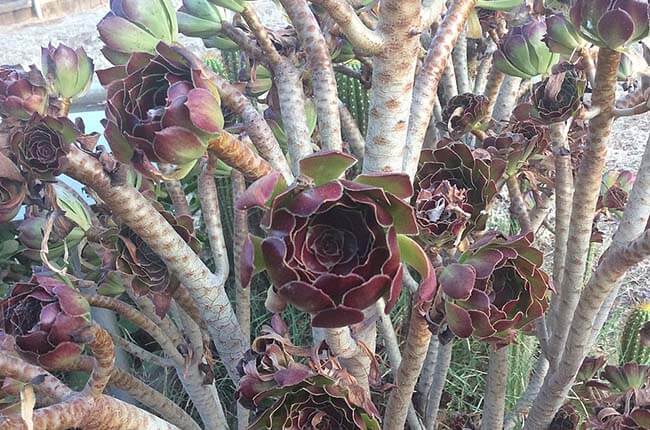
(el cajon yacht club, CC BY 2.0, via Wikimedia Commons)
2. Aeonium tabuliforme
Common name: Dinner Plate Aeonium
True to its name, the Dinner Plate Aeonium has large, flat leaves with flattened rosettes – like dinner plates – that grow close to the ground.
The leaves are broad, thin, and pale green.
During the spring, pale yellow flowers appear at the end of racemes 24 inches tall.

(James Steakley, CC BY-SA 3.0, via Wikimedia Commons)
Agave
3. Agave victoriae-reginae
Common name: Queen Victoria Century Plant
This regal agave plant differs from many agave species in the curve of its leaves.
Each of the leaves, which are medium green with white edges, curve inwards, not unlike an artichoke or clover blossom.
The Queen Victoria Century Plant grows between 1 – 2 feet (30-60cm) tall and 1.5 feet (45 cm) wide.

(Photo by David J. Stang, CC BY-SA 4.0, via Wikimedia Commons)
4. Agave tequilana
Common name: Blue Agave
This popular agave is most famous for being the source of tequila.
True to its name, the thin, sharp leaves are bluish-gray with a powdery finish in mature plants.
Blue agave can grow 7 ft (2.1 meters) tall, with flowering stalks up to 16 ft (5 meters) that produce yellow flowers.

(Stan Shebs, CC BY-SA 3.0, via Wikimedia Commons)
Aloe
5. Aloe Vera
Aloe Vera can grow quite large, up to 24 – 39 inches (60 – 100 cm) tall, with the flowering stems growing up to 40 feet (12 meters) in height.
Clusters of elongated, trumpet-shaped pinkish-orange flowers blossom during the summer after the plant has reached four years of age.
Perhaps the most widely known aloe species, Aloe Vera is hailed for its use in medicinal products. Its gel, which is visible when the leaves are cut open, is a well-known salve for sunburns.

(Dorian Wallender from Lake Havasu City, Arizona, USA, CC BY-SA 2.0, via Wikimedia Commons)
6. Aloe juvenna
Common name: Tiger Tooth Aloe
The toothed, star-shaped rosettes of the Tiger Tooth Aloe are variegated with light green or white speckles along each of the green leaves.
The rosettes grow in columns that can reach 12 inches (30 cm) in height.
When receiving a lot of light, the edges of the leaves turn reddish-brown.

(John Robert McPherson, CC BY-SA 4.0, via Wikimedia Commons)
7. Aloe arborescens
Common name: Torch Aloe
Also known as the Candelabra Aloe, the Torch Aloe is named for its bright red, cone-shaped flowers that bloom between late winter to late summer.
The rosettes consist of long, curved, tapered leaves with toothed edges.
Some varieties are variegated, with white tiger stripes against dark green leaves.
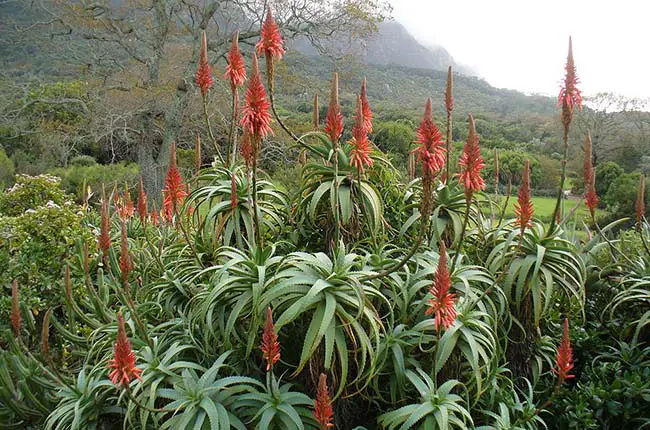
(Andrew massyn, Public domain, via Wikimedia Commons)
Crassula
8. Crassula ovata
Common name: Jade Plant
Perhaps the most recognizable Crassula species, the Jade Plant grows rounded, glossy, fleshy leaves along woody stems and can grow up to 5 feet (1.5 meters) in height.
If the plant receives enough sunlight, the bright green leaves develop red edges due to sun stress.
The Jade Plant produces sprays of tiny white flowers during the spring and summer.
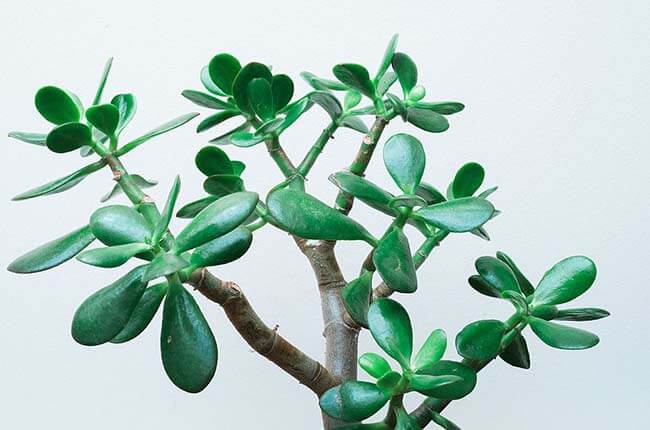
(Karl Thomas Moore, CC BY-SA 4.0, via Wikimedia Commons)
9. Crassula capensis
Common name: The Cape Snowdrop
A dainty succulent that produces clusters of nodding white or pale pink flowers during the spring, the small green rosettes have rounded leaves that grow two leaves per layer.
The plant is native to the Western Cape of South Africa.

(yakovlev.alexey from Moscow, Russia, CC BY-SA 2.0, via Wikimedia Commons)
10. Crassula falcata
Common name: Propeller Plant
This succulent is named for the unusual shape of its long, loosely packed rosette.
The elongated gray-green leaves are offset and can grow up to 6 inches (15 cm) wide, giving each rosette a total diameter of 12 inches (30 cm).
In the summer, the propeller plant produces orange flowers that smell like cinnamon.

(Groogle, CC BY-SA 3.0, via Wikimedia Commons)
Echeveria
11. Echeveria ‘Doris Taylor’
Common name: Woolly Rose
Named for the fuzzy coating on its leaves and stems, the leaves of the Woolly Rose are pale green to dark purplish green in color and produce clusters of bright red-orange flowers during the summer.
The plant grows slowly, but the rosettes can grow up to 7 – 8 inches (18 – 20 cm) in diameter.
12. Echeveria agavoides
Common name: Molded Wax Agave
While the common name of this succulent includes ‘Agave,’ the plant is classified as an echeveria.
The center of the rosette is bright green with red or bright pink ends of the pointed, fleshy leaves. It’s named for its waxy texture.
Depending on the variety, the tips of the leaves can range from hot pink to burgundy.

(Stickpen, Public domain, via Wikimedia Commons)
13. Echeveria chihuahuaensis
Common name: Cat’s Claw
The short, densely packed leaves of this succulent have pointed, thorny tips that curve upwards, lending the plant its common name.
The rosettes reach up to 4 inches (10 cm) in diameter and produce coral-colored flowers during the spring atop tall, thin stems.
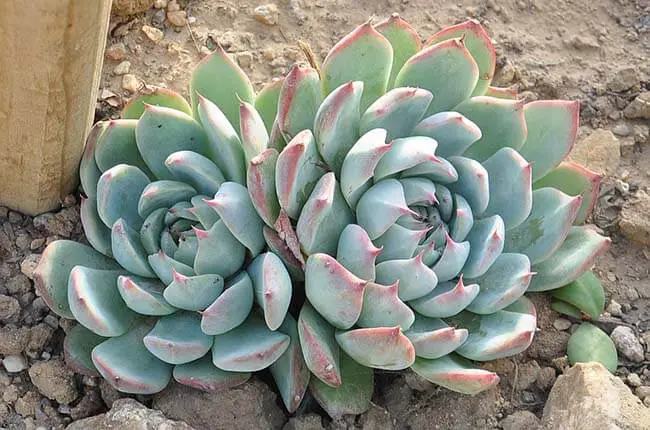
(Jean-Michel Moullec, CC BY 2.0, via Wikimedia Commons)
Graptopetalum
14. Graptopetalum amethystinum
Common name: Lavender Petals
Lavender Petals has round, fleshy, whitish purple leaves with a powdery finish.
During the spring and summer, clusters of tiny red and yellow flowers appear in the center of the rosettes on short, thin stems.

(Armando Olivo Martín del Campo, CC BY-SA 4.0, via Wikimedia Commons)
15. Graptopetalum bellum
Common name: Chihuahua Flower
The Graptopetalum bellum, also known as “Tacitus bellus”, is a hybrid, and is characterized by its flat, dark colored rosettes of densely layered leaves.
Its stunning five-petaled, star-shaped flowers are bright pink and appear during the spring and summer in clusters atop stems 3 – 4 inches (8-10cm) tall.
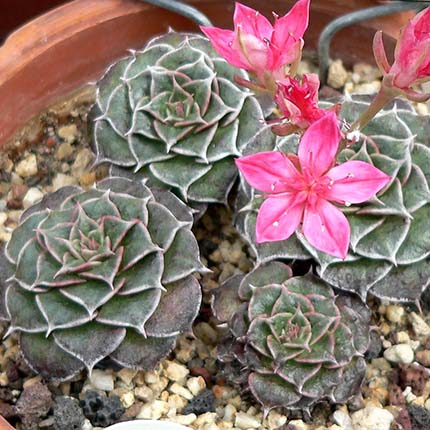
(Stan Shebs, CC BY-SA 3.0, via Wikimedia Commons)
16. Graptopetalum macdougallii
Common name: Leatherpetal
Graptopetalum macdougallii is an epiphytic succulent, growing off rocks and other plants rather than from the soil.
New rosettes are produced by offsets at the end of long, trailing stems, making the plant spread easily.
This succulent’s bright green or blue-green leaves are densely packed in rosettes measuring 3 inches (8 cm) wide.
The five-petaled flowers appear in the spring and are bright reddish pink.
Graptopetalum macdougallii makes an attractive succulent for groundcovers and hanging baskets due to its trailing vines.
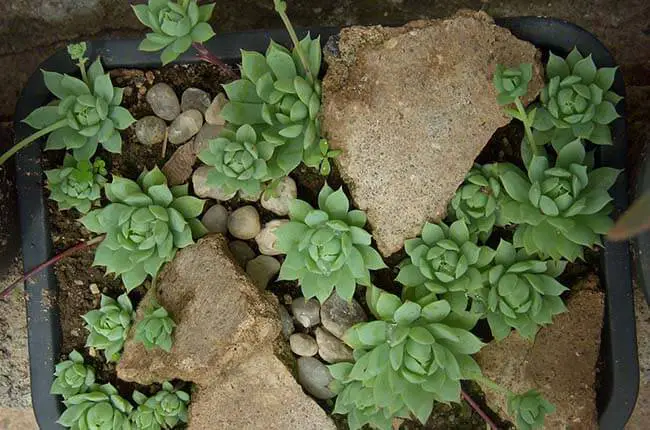
(Graptopetalum macdougallii) (Dianakc, CC BY-SA 3.0, via Wikimedia Commons)
Graptosedum
17. Graptosedum ‘California Sunset’
This eye-catching succulent is a hybrid of Ghost Plant (graptopetalum paraguayense) and Sedum adophii.
It is named for its reddish-purple foliage that becomes more pronounced as the plant receives more sunshine.
The leaves are thick with a thin powdery finish, pointed at the tips, and the plant blooms white flowers in the spring.
18. Graptosedum ‘Francesco Bald’
A hybrid between graptopetalum paraguayense and Sedum pachyphyllum, Francesco Baldi is also known as Blue Pearl, Darley Sunshine, Edelfrau, Frostbite, and Pink Beauty.
Its plump, lance-shaped leaves can grow 3 inches (8 cm) long, with the plant’s average mature size being 6 inches (15 cm) tall and 5 inches (13 cm) wide.
The leaves are pinkish yellow during the summer months and take on a dark brownish purple in the winter. Flowers are yellow and bloom during the spring.
19. Graptosedum hybrid
Common name: Alpenglow
A pink succulent, Alpenglow trails over the sides of its container as it grows larger, making it a great groundcover.
The rosettes have pointed leaves and grow close against the trailing stems.
Its yellow flowers bloom in the spring.
Orostachys
These unique succulents grow low to the ground and are ideal for ground covers.
20. Orostachys spinosa
Common name: Spiny pennywort
This popular Orostachys species resembles a sunflower, with a wide, leafless center surrounded by short, pointed “petals.”
The grayish green rosettes grow slowly and only reach a width of 2.5 inches (6 cm) in diameter.
The monocarpic succulent produces clusters of tiny, greenish-yellow flowers atop racemes that can reach 12 inches (30 cm) in height.
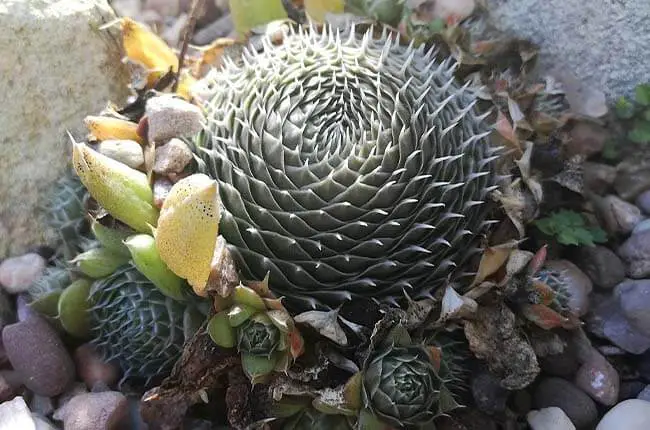
(S Molteno, CC BY-SA 4.0, via Wikimedia Commons)
21. Orostachys japonica
Common name: Rock Pine
The spiny rosettes of Rock Pine are green or yellowish green that gains red tips during the winter.
The rosettes shrink during the winter and are only half an inch (1 cm) across, while in the summer they grow over 3 inches (7.5 cm) wide.
Tiny white flowers appear atop tall stems that are 12 inches (15 cm) long during the summer from the rosette’s centers.
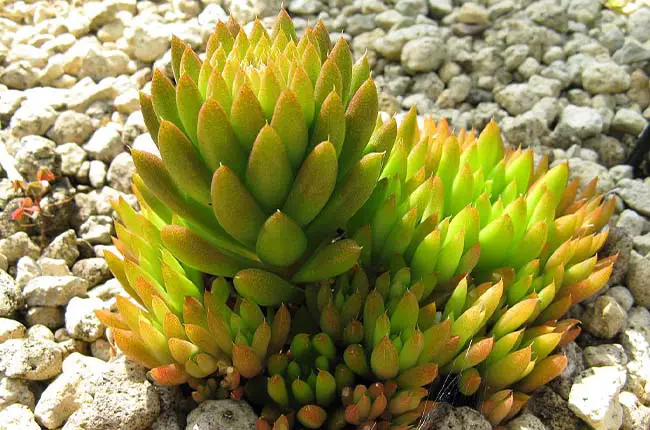
(KENPEI, CC BY-SA 3.0, via Wikimedia Commons)
22. Orostachys iwarenge
Common name: Chinese Dunce Cap
Named for the vertical, cone-shaped centers of the rosettes that appear during the plant’s blooming season in the fall, this plant actually originated from Japan rather than China.
The rosettes are silver in color with flat, rounded leaves and produce offsets on long, thin stalks.
Being monocarpic, it produces death blooms in fall with tiny yellow flowers rising from the center of each rosette.
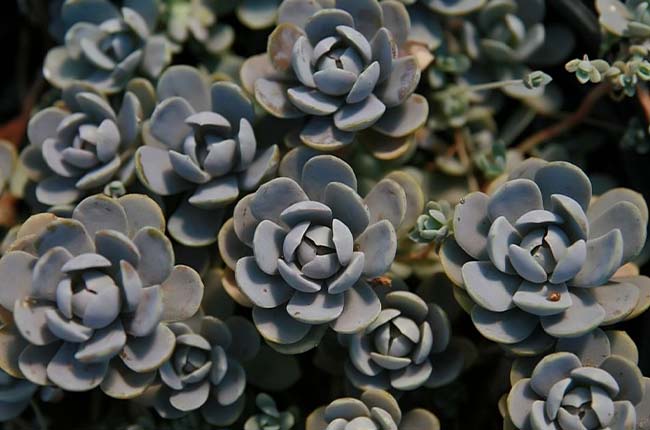
(Orostachys iwarenge) (Qwert1234, CC BY-SA 4.0, via Wikimedia Commons)
Pachyphytum
23. Pachyphytum compactum
Common name: Little Jewel
This succulent is named for its unusual leaves, which resemble cut, faceted gemstones. The grayish-blue leaves have a powdery white finish.
Native to the rocky regions of Hidalgo, Mexico, Little Jewel grows 5 – 6 inches (13-15 cm) wide. In the summer, small yellow blooms appear that blossom atop 12-inch (30-cm)-tall stems.
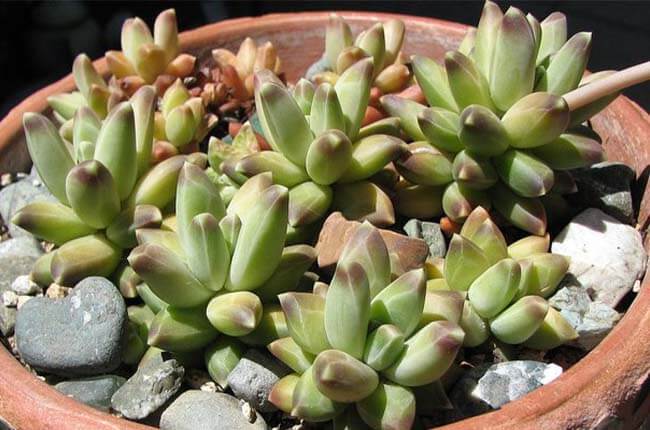
(Seán A. O’Hara, CC BY 2.0, via Wikimedia Commons)
24. Pachyphytum longifolium
An unusual hybrid between Graptopetalum amethystinum and Echeveria colorata, this succulent has fleshy, elongated silvery leaves with a powdery finish.
Keep it in full sun during the winter months for the leaves to turn pink.
During the spring and summer, Pachyphytum longifolium produces nodding, bell-shaped pale pink flowers atop upright stems.
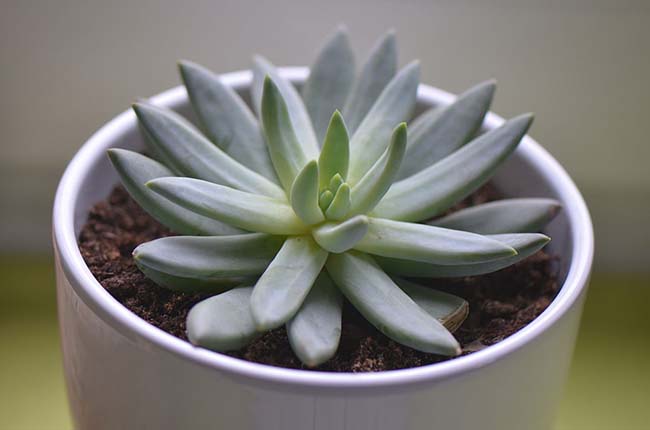
(Jean.claude, CC BY-SA 3.0, via Wikimedia Commons)
25. Pachyphytum oviferum
Common name: Pink Moonstone
This compact succulent gets its name from its round, fleshy leaves that grow low to the ground. The pink hue only appears if the plant is under sun stress.
Pink Moonstone only grows to a height of 2 inches (5 cm) but can spread up to 10 inches (25 cm) wide in clusters.
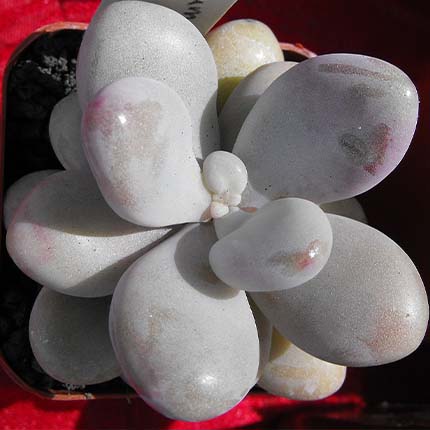
(Stickpen, Public domain, via Wikimedia Commons)
Pachyveria
26. Pachyveria scheideckeri
Common name: Jeweled Crown
Jeweled Crown has fleshy, powdery blue-gray leaves, each with a distinctive red tint.
It’s a hybrid species, and as such, can have unpredictably sized rosettes ranging from small (only 1-2 inches or 5 cm across) to larger ones of 5 – 6 inches (13 – 15cm) wide.
The rosettes grow atop short woody stems that are 1 – 2 inches (3-5 cm) in height.
This monocarpic plant produces yellow-orange death blooms once in its life during the spring and summer.
27. Pachyveria myrtilla
This hybrid succulent is also known as echeveria violescens, as it is a cross between echeveria and pachyveria.
The powdery foliage is reddish green, turning bright purple or mauve with increased sunlight, with spoon-shaped leaves.
Pachyveria myrtilla grows 10 inches (25 cm) across. During the summer, it produces clusters of bell-shaped red flowers, similar to those of Blue Tongue. The flowers grow atop tall, thin reddish-purple stems that grow up to 2 ft (60 cm) tall.
28. Pachyveria glauca
Common name: Blue Tongue
Another pachyveria x echeveria hybrid, Blue Tongue has short, stubby rounded leaves that are bluish-green in color, giving the plant its popular name.
Newer leaves are small and bluish-silver in color, while the larger, outer leaves are a darker blue-green. Each leaf is rimmed with pinkish red.
They grow fastest during the winter and produce bright red, bell-shaped flowers atop upright reddish-purple stems beginning in late spring.
Prometheum
29. Prometheum aizoon
The densely packed, brown-tinged rosettes of the prometheum aizoon form tight, round clusters.
The leaves are oval and slightly flattened.
During the summer, funnel-shaped flowers appear atop 4 inch- (10 cm) tall stems and can be white or yellow, sometimes with a purple or pink tinge.
30. Prometheum pilosum
Best known for its leaves with spikes, prometheum pilosum grows in small clusters in rocky soil.
The green rosettes are small, stout, and dense.
They grow in rounded clusters.
It’s monocarpic, forming a cone that grows upwards, upon which the flowers bloom.

(Ghislain118 (AD) http://www.fleurs-des-montagnes.net, CC BY-SA 3.0, via Wikimedia Commons)
Rosularia
31. Rosularia platyphylla
Common name: Turkish Stonecrop
Native to the rocky mountain regions of the Middle East and Central Asia, Turkish Stonecrop has rosettes with glossy, pale green, spoon-shaped leaves and grows either in single rosettes or in clusters of 3 – 5.
The leaves are finely haired to protect the plant from extreme temperatures.
During the summer, elongated white flowers bloom atop straight vertical stems that reach about 6 inches in height. Like other stonecrop varieties, it is monocarpic.

(Ghislain118 (AD), CC BY-SA 3.0, via Wikimedia Commons)
32. Rosularia alpestris
Common name: Lower Mountain Sedum
Lower Mountain Sedum has rosettes that are loose and not as densely packed as many other rosette succulents. The foliage is green and soft.
It is characterized by its tiny white, star-shaped flowers that bloom during the summer in buds along a vertical red stem.
Lower Mountain Sedum is native to the Middle East and Central Asia, especially in the lower alpine regions of the Himalayan Mountains.
Sedum
Most sedum species are also known as “stonecrop,” due to the way they grow close to the ground with small, compact rosettes. They make great groundcovers for this reason, and most have colorful blooms.
33. Sedum spurium
Common name: Dragon’s Blood
Dragon’s Blood is a popular succulent for rock gardens, borders, and groundcovers because it grows low to the ground and spreads easily.
It is named for its vivid crimson flowers that bloom during the summer atop short stems and its red-tinged fringed leaves.
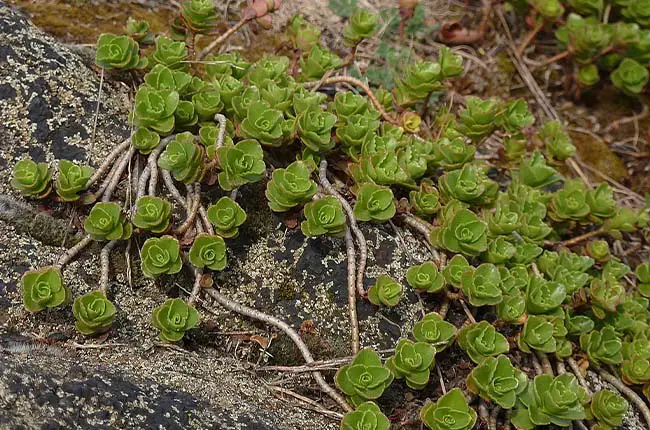
(Katrin Schneider, korina.info – CC-BY-SA-4.0, CC BY-SA 4.0, via Wikimedia Commons)
34. Sedum Kamtschaticum
Common name: Orange Stonecrop
As this plant’s name suggests, the flowers that bloom during the late summer are yellow or orange and grow in dense clusters. The lance-shaped leaves are green, glossy, and toothed at the ends.
Like other stonecrops, Orange Stonecrop makes a wonderful ground cover, growing 3 – 6 inches (8-15 cm) tall and 10 – 15 inches (25-38 cm) wide.
Sempervivium
Sempervivium varieties make great groundcovers, due to the way they grow close to the ground and spread out. Their dense rosettes form tight clusters that are attractive in borders, rock gardens, and xeriscaping.
Most semperviviums are monocarpic, producing death blooms once before developing seeds and dying. However, where the seeds land, new semperviviums often appear.
35. Sempervivum heuffelii
Common name: Purple Haze
Native to the European Carpathian Mountains, sempervivum heuffelii is also known as Hen and Chicks. Purple Haze is named for the succulent’s distinctive purple hue.
Unlike many other succulents, the round-leaved rosettes don’t lose their colors during the winter.
Purple Haze grows about 8 inches (20 cm) in height, with rosettes growing in clusters of 3 – 4. During the summer, the plant will produce a single yellow flower that measures about 2 inches (5 cm) across.

(Agnieszka Kwiecień, Nova, CC BY-SA 4.0, via Wikimedia Commons)
36. Sempervivum tectorum
Common name: Common Houseleek, Hens and Chicks
Growing 6 inches (15 fcm) tall and 20 inches (50 cm) wide, the Common Houseleek has tufted, grayish-green leaves that often have a reddish-pink tinge. During the summer, it produces pink blossoms atop fuzzy stems.
In ancient Rome, it was believed that the Common Houseleek could protect houses against lightning strikes.
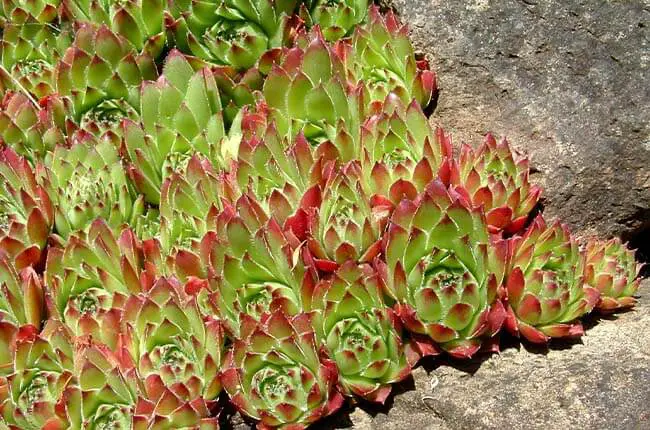
(Paul Harrison, CC BY-SA 4.0, via Wikimedia Commons)
Related
14 Fragrant Succulents & Cacti
13 Stunning Cacti by Flower Color
- Keiki Paste vs Rooting Hormone:What’s the difference? - February 4, 2024
- Top 10 Orchid Fertilizers: A Comprehensive Review (2024) - February 2, 2024
- Top 8 Soil Inoculants For Stronger Plants (2024) - February 1, 2024
